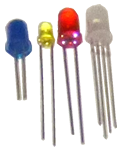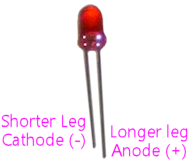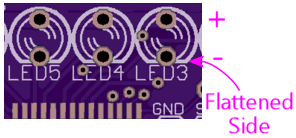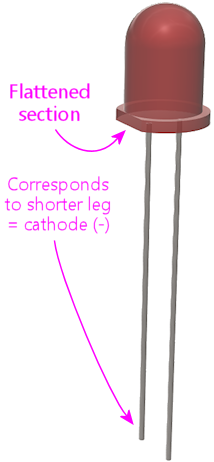75. LEDs
LEDs are in fact diodes - it's right in the name, Light Emitting
Diode. They're just a special type of diode that glows when current
is flowing.
Using an LED in a circuit board is mostly like using any other diode
in a circuit board, so you might want to take a look at
Diodes. The main difference with an LED is that the
physical package is usually a little different. Through-hole LEDs
usually use "radial" packages, with two leads sticking out of the
bottom.
Static electricity warning
Identifying the positive and negative legs
Regular diodes use a stripe on the body to indicate the negative end,
but that doesn't work for most LEDs because of the different package
shape. Instead, LEDs usually indicate the positive and negative
sides using a longer leg and a shorter leg:
It's actually kind of mnemonic: shorter = minus.
The negative lead of an LED is also known as the cathode; the positive
lead is the anode. (Here's my handy trick for remembering which is
which. Remember CRT TVs? CRT stands for Cathode Ray Tube. We know
that a "Cathode Ray" is actually an electron, and that electrons have
negative charge. So the cathode is the negative side.)
Orienting on a circuit board
The circuit board markings for an LED will indicate the orientation,
either by marking one of the pads with a "+" sign for the "+" leg, or
via the outline on the circuit board. If it's indicated via the
outline, one side of the outline circle will be flattened:
The flat side on the diagram corresponds to the flat side on the base
of the LED's plastic bubble. It's pretty subtle on smaller parts -
so much so that I can't get a good photo. Instead, here's a 3D
rendering that exaggerates it enough to see clearly:
To orient the LED for installation, line up the flat side on the base
of the bubble with the flat side of the outline on the circuit board.
If there's not an obvious flat side, match up the short leg on the LED
with the flattened side on the circuit board outline.
On schematics
The schematic symbol for an LED reflects that it's really a diode, by
using the same basic symbol. But there's also a little embellishment
added to show the special light-emitting feature: a couple of little
arrows pointing out, representing the photons being emitted.
As with a regular LED, the arrow points from positive to negative,
so the side with the "bar" is the negative lead or cathode.
LED specs
LEDs are characterized mainly by two values: the forward voltage
and forward current.
A lot of people get confused about the forward voltage number,
thinking that it means the required supply voltage. That's a
completely reasonable mistake, because for just about any other kind
of device, a "voltage" spec would mean just that. But for an LED,
it's something different. The forward voltage is actually the voltage
that the LED "drops" in the circuit, which is sort of like consuming
the voltage. In order for an LED to function, it must be supplied
with more than its forward voltage.
For example, if you have an LED rated with a forward voltage of 3.5V,
it'll work if you supply it with 5V, since 5V is greater than the
rated forward voltage. It won't work if you supply it with 3V,
because that's less than the rated forward voltage.
The supply voltage has to be higher than the LED's forward voltage,
but it's more efficient if it's not too much higher. The
higher the voltage, the more power has to be wasted in
current-limiting resistors. For example, if you have an LED with a
3.5V forward voltage, and you have a choice of powering it with a 5V
or a 12V supply, you should choose the 5V supply. Both 5V and 12V
are above the required threshold, so either one will work, but 5V
is more efficient because it's the lower voltage option.
You often see LEDs rated with a range for the forward voltage, such as
"3.2V - 3.4V". That just means that there are some variations in the
manufacturing process, so individual LEDs will each be a little
different, but each one should be somewhere in that range. If you're
trying to figure the required supply voltage, just make sure the
voltage is higher than the high end of the range.
The other spec for an LED is the forward current. That's more
straightforward: that actually is the current level that you're
supposed to use with the LED. You might also see a separate maximum
forward current; this is a level you should never exceed. LEDs don't
vary much in brightness when you change the current level, but they do
get hotter, so there's usually no benefit in using a higher current
than the recommended forward current. Doing so just reduces the
lifetime of the part.
Selection
LEDs are usually placed in a circuit solely for their ability to emit
light, as opposed to serving some kind of active function that affects
the other electronics in the circuit. This makes them more
interchangeable than regular diodes, where the circuit designer might
be relying on a particular diode's special electronic characteristics.
So in most cases, the only two things that matter when selecting an
LED are its forward voltage and forward current ratings.
And you don't typically have to match these exactly - you just need
compatibility. What constitutes compatibility depends on the circuit:
- If the circuit has active current regulation, so that it won't
exceed a given current level through the LED, an LED is compatible
with the circuit if the LED's forward voltage is lower than the
power supply voltage in the circuit, and the LED's maximum
forward current rating is at least the regulated current level that
the circuit uses.
For example, if your circuit board provides 5V power to an LED
with current regulated to 20mA, you can use an LED with a forward
voltage of 2V (because 2V is less than the 5V supply voltage)
and a maximum current rating of 50mA (because 50mA is greater
than the regulated 20mA). You can't use an LED with
a forward voltage of 6V, because that exceeds the 5V supply
voltage.
- If the circuit board uses a resistor to regulate the current (see
LED Resistors, and you can't substitute a different
resistor, you can use any LED with approximately the same forward
voltage that the circuit designer specified, and with a maximum
current rating at least as high as the forward current that the
circuit designer specified. I can't give you a hard-and-fast
rule for exactly how "approximate" you can be, but let's say
within 10% or so.
For example, if your circuit board uses a resistor to regulate
current and calls for an LED with a 3.2V forward voltage and
20mA forward current, you can use any LED with a forward voltage
of about 2.9V to 3.5V (within 10% of the specified 3.2V), and a
maximum forward current of 20mA or higher.
- If the circuit board uses a resistor to regulate the current,
and you can substitute your own resistor in place of what
the designer specified, you can use any LED with a forward voltage
less than the supply voltage in the circuit.
In this case, you'll
have to select an appropriate resistor based on the LED you actually
end up using. See LED Resistors for
the formula
an on-line calculator
for selecting the resistor. When figuring the resistor value,
use the LED's forward voltage spec, and use the desired current
in the circuit. The desired current must be less than or equal
to the maximum current specified for the LED, and it must also
be less than or equal to the maximum current that the circuit
can safely supply. For that, you'll have to consult the circuit
board's specifications or ask the designer.
If you're installing an LED in a circuit board, it also obviously has
to match the physical size and shape that the board was designed for.





